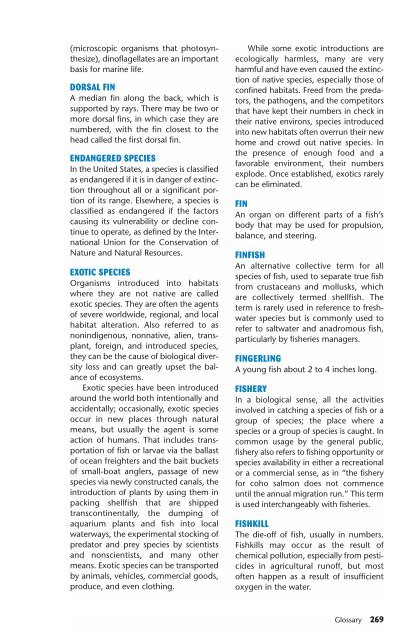Ken Schultz's Field Guide to Saltwater Fish - Macaw Pets store
Ken Schultz's Field Guide to Saltwater Fish - Macaw Pets store
Ken Schultz's Field Guide to Saltwater Fish - Macaw Pets store
Create successful ePaper yourself
Turn your PDF publications into a flip-book with our unique Google optimized e-Paper software.
(microscopic organisms that pho<strong>to</strong>synthesize),<br />
dinoflagellates are an important<br />
basis for marine life.<br />
DORSAL FIN<br />
A median fin along the back, which is<br />
supported by rays. There may be two or<br />
more dorsal fins, in which case they are<br />
numbered, with the fin closest <strong>to</strong> the<br />
head called the first dorsal fin.<br />
ENDANGERED SPECIES<br />
In the United States, a species is classified<br />
as endangered if it is in danger of extinction<br />
throughout all or a significant portion<br />
of its range. Elsewhere, a species is<br />
classified as endangered if the fac<strong>to</strong>rs<br />
causing its vulnerability or decline continue<br />
<strong>to</strong> operate, as defined by the International<br />
Union for the Conservation of<br />
Nature and Natural Resources.<br />
EXOTIC SPECIES<br />
Organisms introduced in<strong>to</strong> habitats<br />
where they are not native are called<br />
exotic species. They are often the agents<br />
of severe worldwide, regional, and local<br />
habitat alteration. Also referred <strong>to</strong> as<br />
nonindigenous, nonnative, alien, transplant,<br />
foreign, and introduced species,<br />
they can be the cause of biological diversity<br />
loss and can greatly upset the balance<br />
of ecosystems.<br />
Exotic species have been introduced<br />
around the world both intentionally and<br />
accidentally; occasionally, exotic species<br />
occur in new places through natural<br />
means, but usually the agent is some<br />
action of humans. That includes transportation<br />
of fish or larvae via the ballast<br />
of ocean freighters and the bait buckets<br />
of small-boat anglers, passage of new<br />
species via newly constructed canals, the<br />
introduction of plants by using them in<br />
packing shellfish that are shipped<br />
transcontinentally, the dumping of<br />
aquarium plants and fish in<strong>to</strong> local<br />
waterways, the experimental s<strong>to</strong>cking of<br />
preda<strong>to</strong>r and prey species by scientists<br />
and nonscientists, and many other<br />
means. Exotic species can be transported<br />
by animals, vehicles, commercial goods,<br />
produce, and even clothing.<br />
While some exotic introductions are<br />
ecologically harmless, many are very<br />
harmful and have even caused the extinction<br />
of native species, especially those of<br />
confined habitats. Freed from the preda<strong>to</strong>rs,<br />
the pathogens, and the competi<strong>to</strong>rs<br />
that have kept their numbers in check in<br />
their native environs, species introduced<br />
in<strong>to</strong> new habitats often overrun their new<br />
home and crowd out native species. In<br />
the presence of enough food and a<br />
favorable environment, their numbers<br />
explode. Once established, exotics rarely<br />
can be eliminated.<br />
FIN<br />
An organ on different parts of a fish’s<br />
body that may be used for propulsion,<br />
balance, and steering.<br />
FINFISH<br />
An alternative collective term for all<br />
species of fish, used <strong>to</strong> separate true fish<br />
from crustaceans and mollusks, which<br />
are collectively termed shellfish. The<br />
term is rarely used in reference <strong>to</strong> freshwater<br />
species but is commonly used <strong>to</strong><br />
refer <strong>to</strong> saltwater and anadromous fish,<br />
particularly by fisheries managers.<br />
FINGERLING<br />
A young fish about 2 <strong>to</strong> 4 inches long.<br />
FISHERY<br />
In a biological sense, all the activities<br />
involved in catching a species of fish or a<br />
group of species; the place where a<br />
species or a group of species is caught. In<br />
common usage by the general public,<br />
fishery also refers <strong>to</strong> fishing opportunity or<br />
species availability in either a recreational<br />
or a commercial sense, as in “the fishery<br />
for coho salmon does not commence<br />
until the annual migration run.” This term<br />
is used interchangeably with fisheries.<br />
FISHKILL<br />
The die-off of fish, usually in numbers.<br />
<strong>Fish</strong>kills may occur as the result of<br />
chemical pollution, especially from pesticides<br />
in agricultural runoff, but most<br />
often happen as a result of insufficient<br />
oxygen in the water.<br />
Glossary 269


